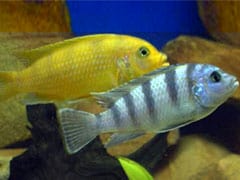
Common name: Kenyi, Blue Kenyi, Kenyi Cichlid, Kenyii, Kennyi
Scientific name: Pseudotropheus lombardoi, Pseudotropheus liliancinius, P. kennyi
Average Adult Fish Size: 12cm / 4 Inches
Place of Origin: Lake Malawi
Typical Tank setup: Rocky Malawi tank
Recommended Minimum Aquarium Capacity: 160 Litres
Compatibility: Other Lake Malawi cichlids, generally aggressive ones.
Temperature: 23-28 Deg C / 73-82 Deg F
Water chemistry: pH 7.6-8.6
Feeding: Omnivorous – but in its diet, plant/vegetable matter should be plentiful.
Sexing: Once out of the juvenile stage, sexing is easy. The males will become a very bright yellow.
Breeding: Like most malawi cichlids, the kennyi is a mouth brooder. As such, it is easier to breed this cichlid than many other types of fish. It takes about 3 weeks for fry to emerge once the mother starts holding eggs in her mouth. Fry should be fed crushed cichlid flake fod or newly hatched brine shrimp.
Additional Information: The Lombardoi has a “typical” Mbuna shape. The coloring depends on the age and sex of the fish. Females are pale blue to deep blue with six to eight transverse, black bands. The bands are begin at the crest of the black and fade in color as they move down towards the belly. The first band runs to the eye and the last is located near the tail. The belly is lighter in color. The fins are light blue and the caudal fin has some vertical, spotted lines. The dorsal fin has five dark splotches where the longitudinal bands end, and has a black fringe. Males are yellow in color and may or may not have the transverse bands that the female possesses. The fins match the body color. These fish are known to be highly aggressive and territorial, and often injure or kill other fish sharing its tank. Aggressive males exhibit territoriality by digging pits in the gravel or sand, staking its claim and defending it fiercely. To prevent casualties, the aquarium should be spacious and rocky with several hiding places. It can be kept with other cichlids of Lake Malawi, preferably other mbuna with the similar level of aggressiveness.


Related Posts
Croaking Gourami – Trichopsis vittatus
Benthochromis Tricoti
Large-eyed Mouthbrooder – Callochromis Macrops